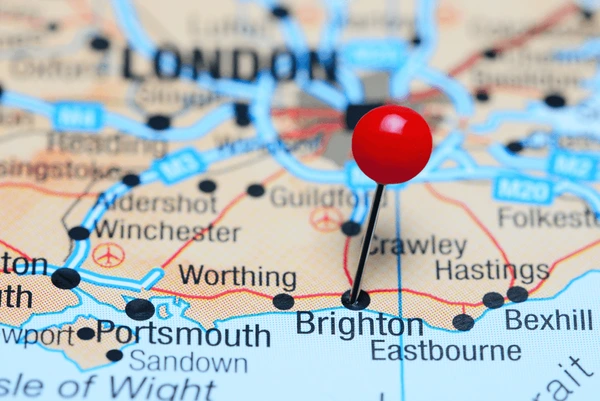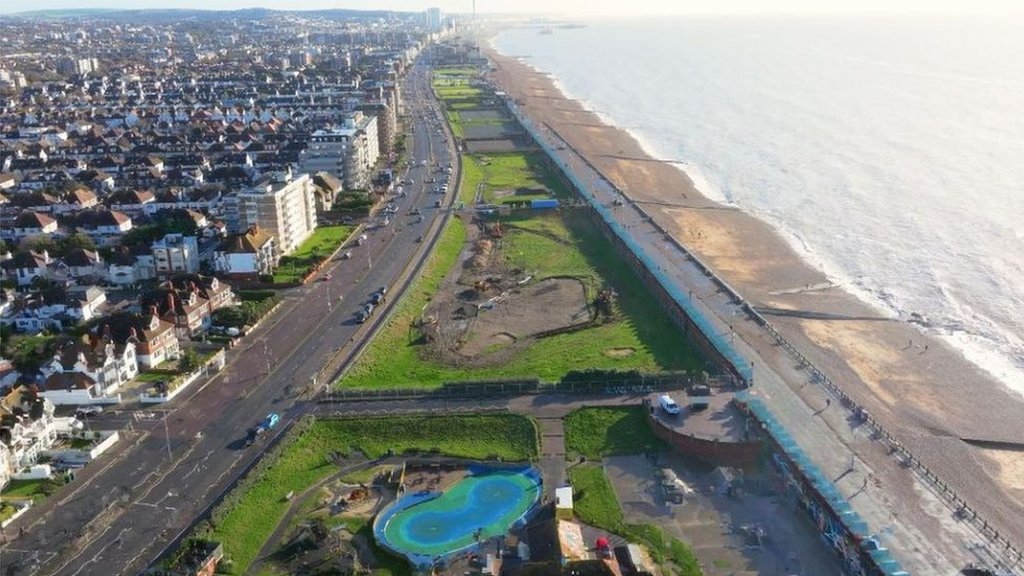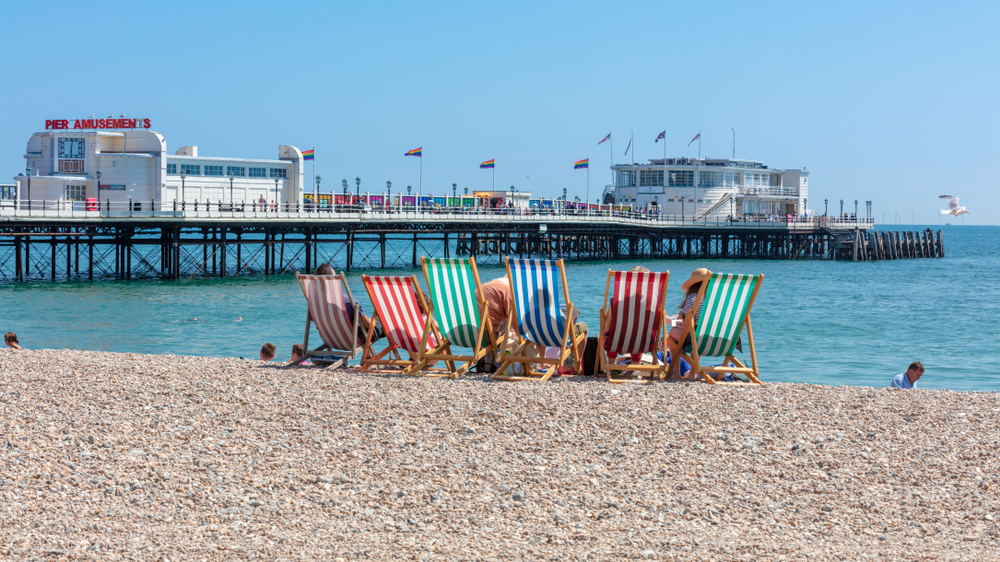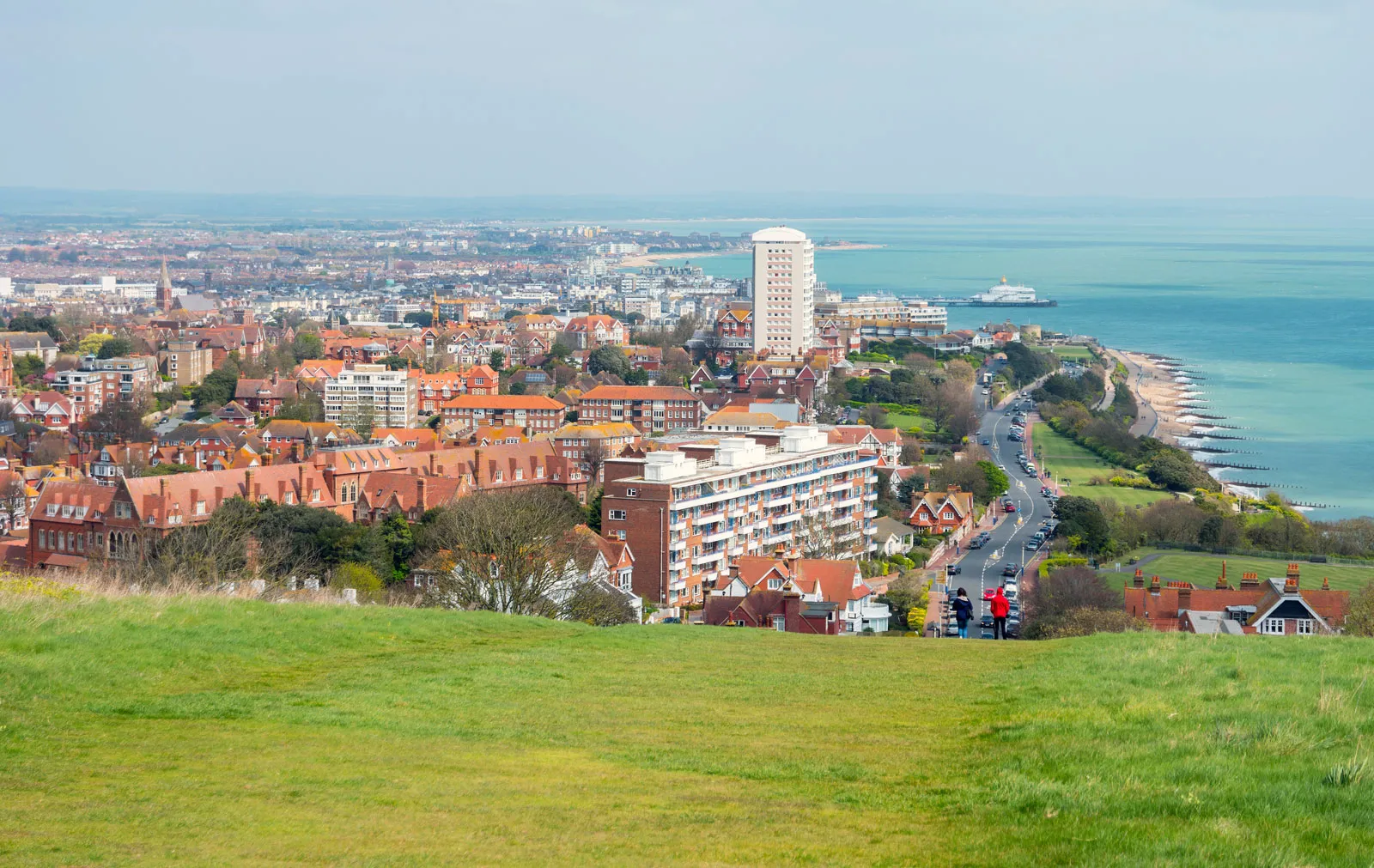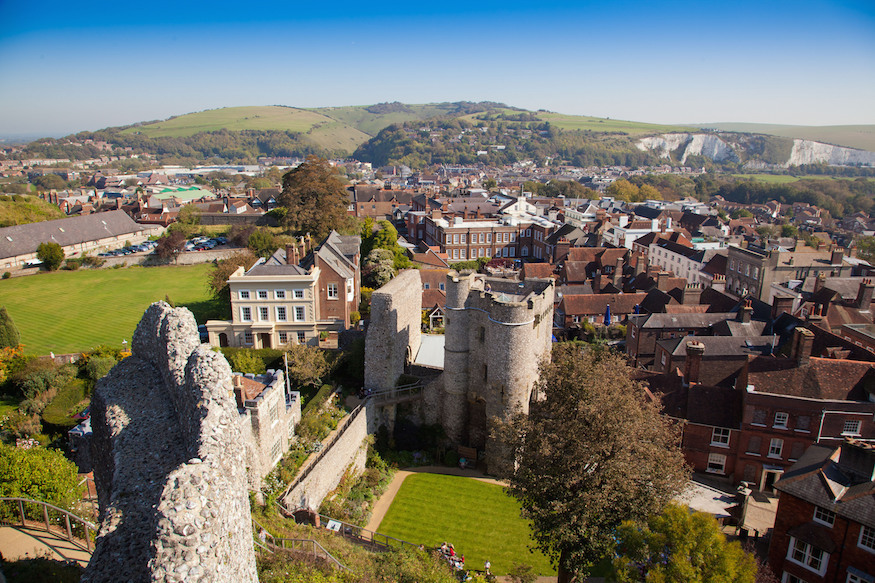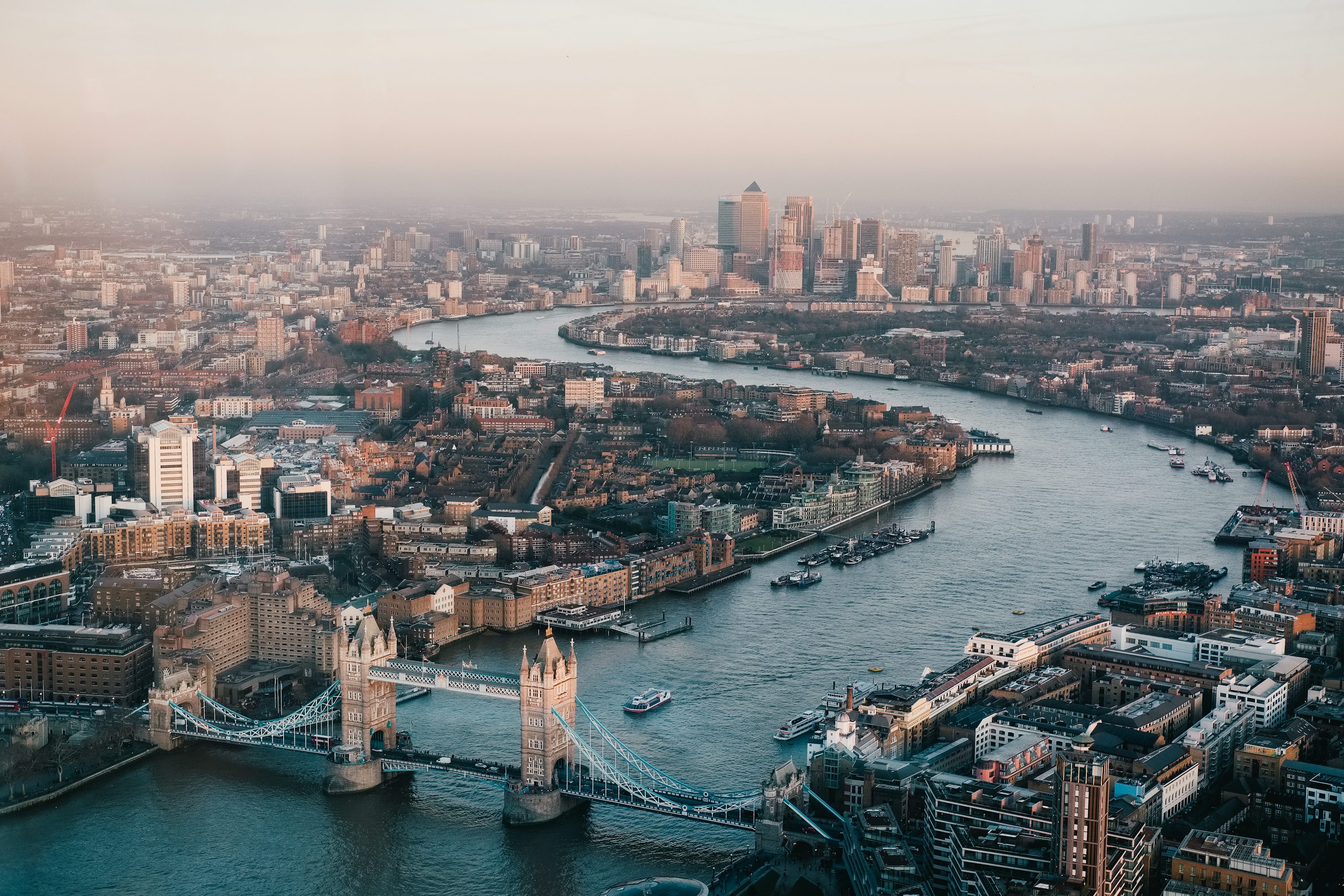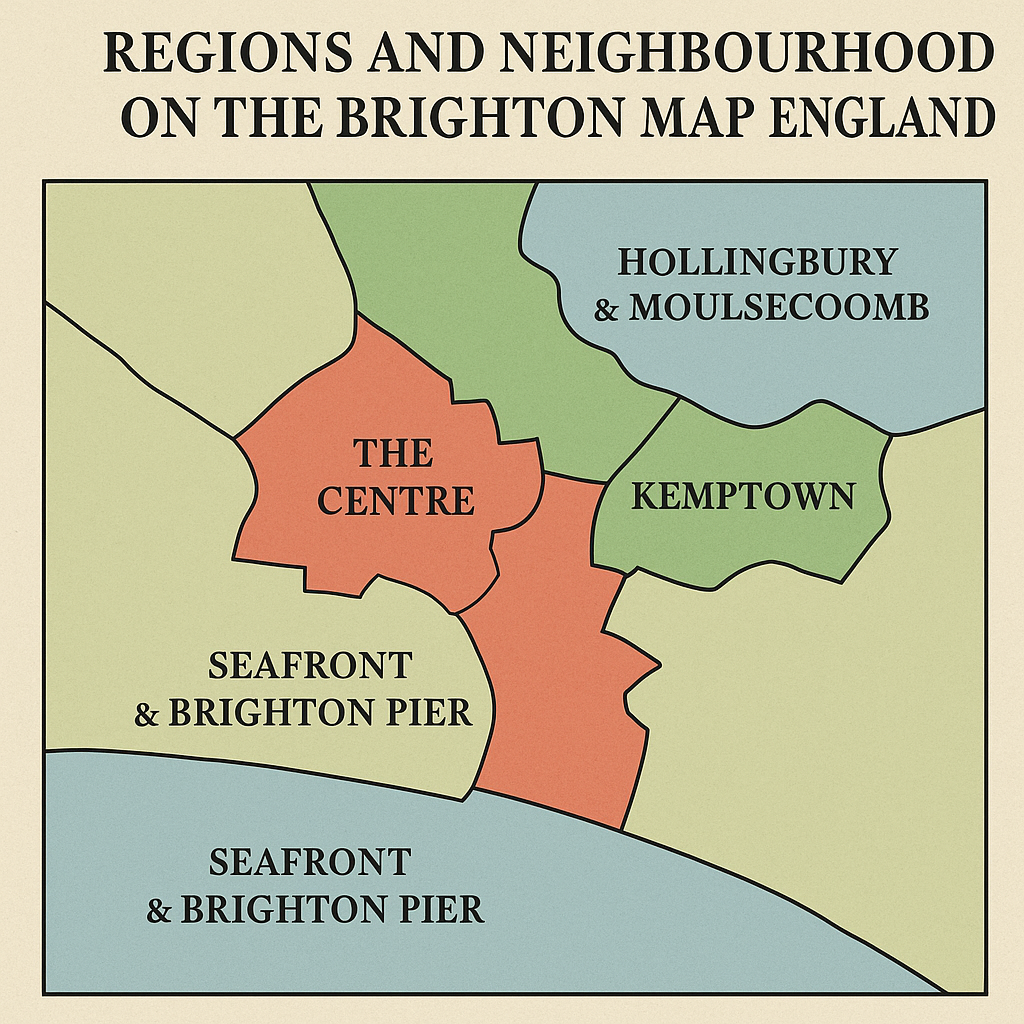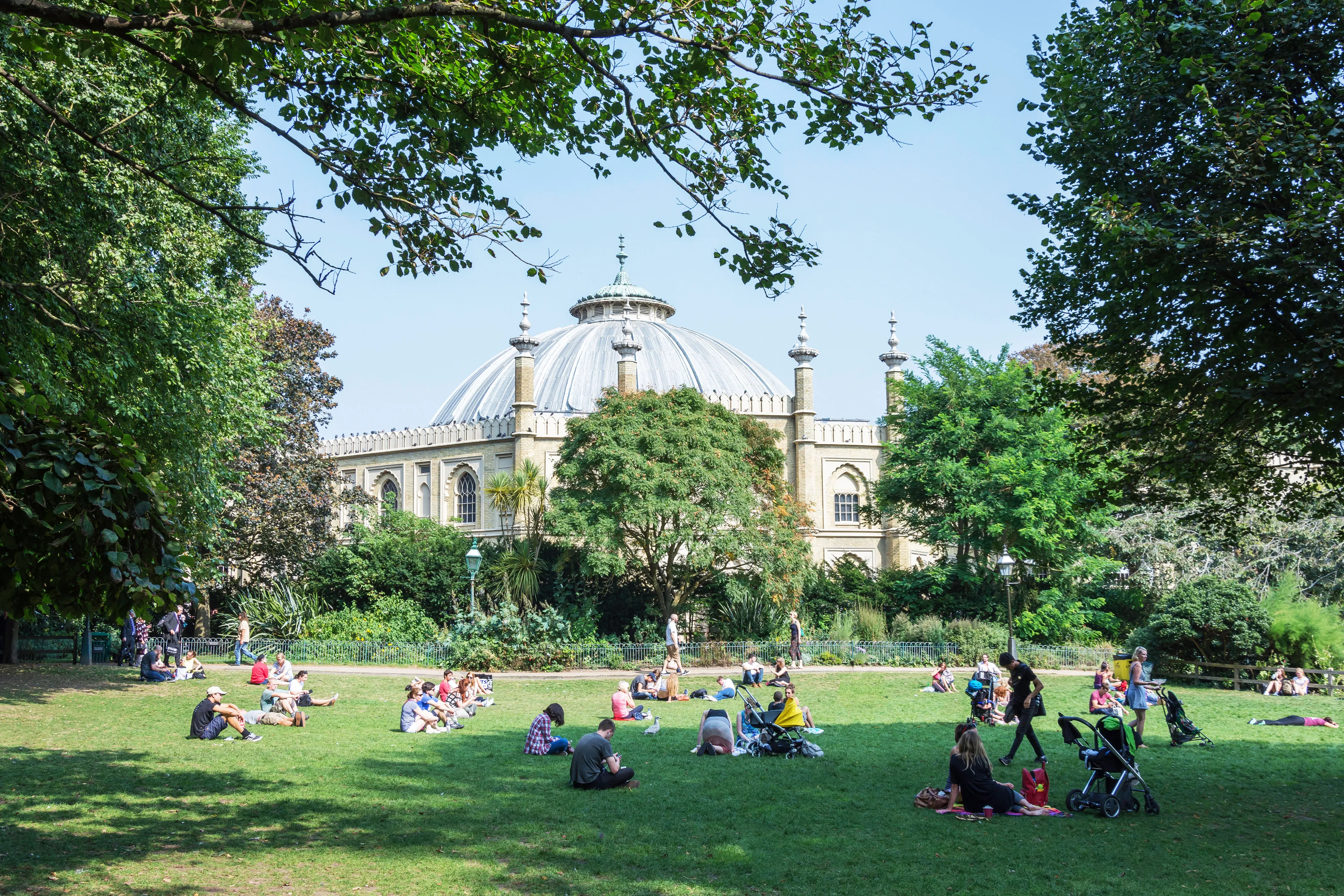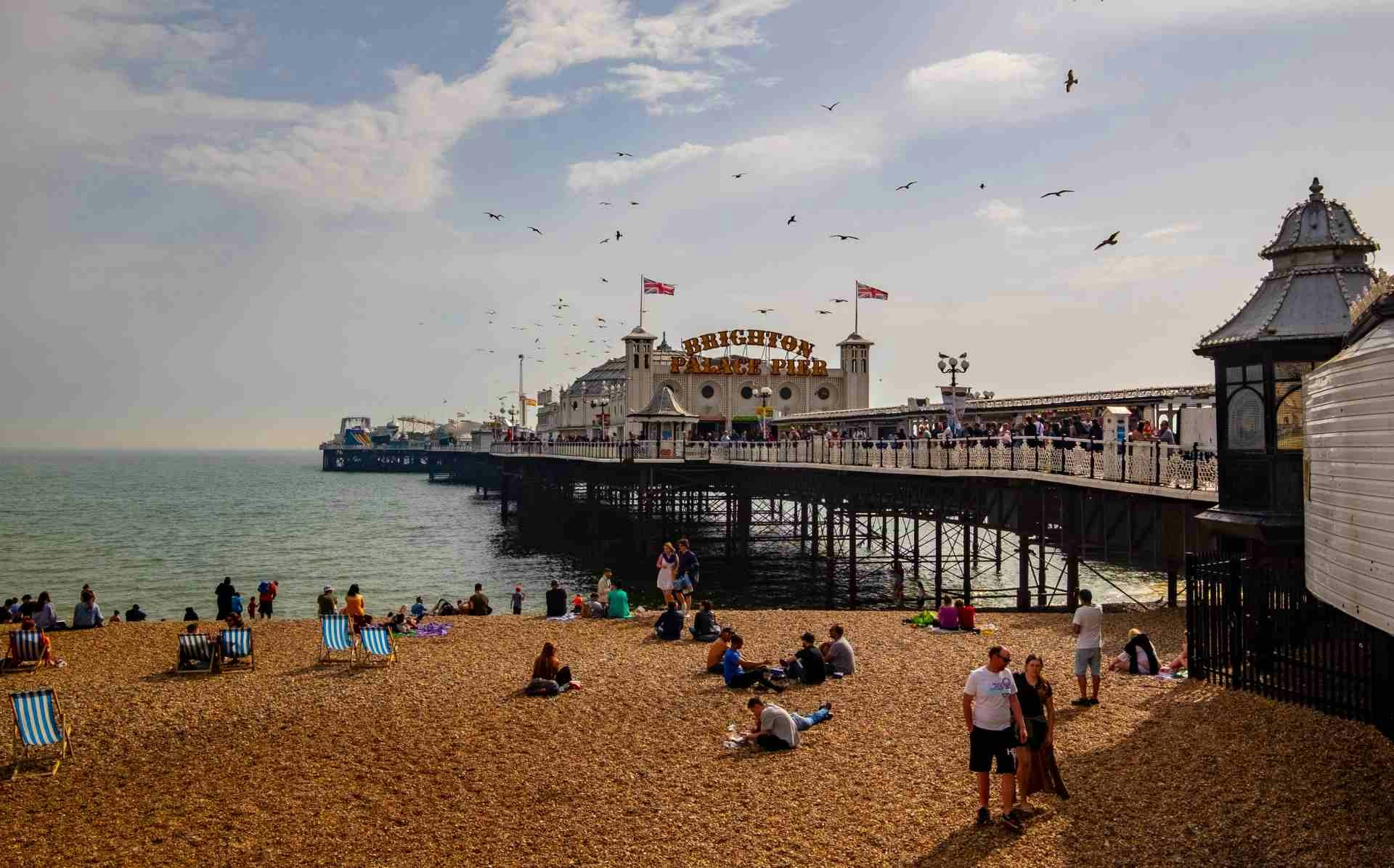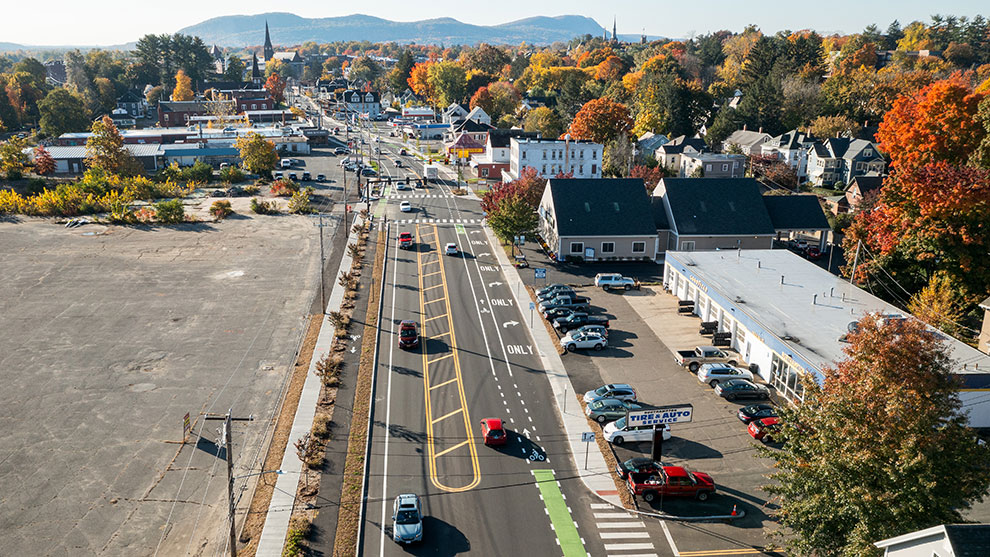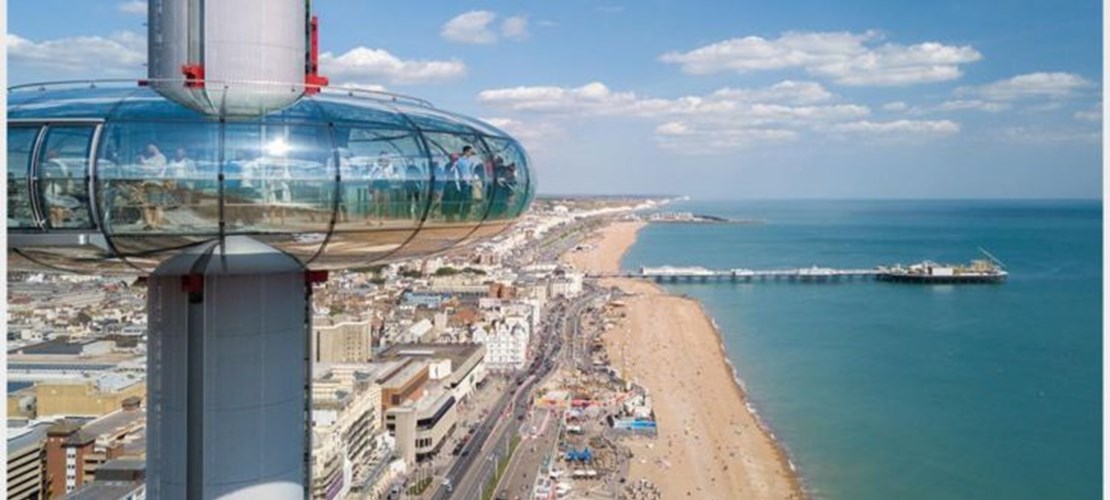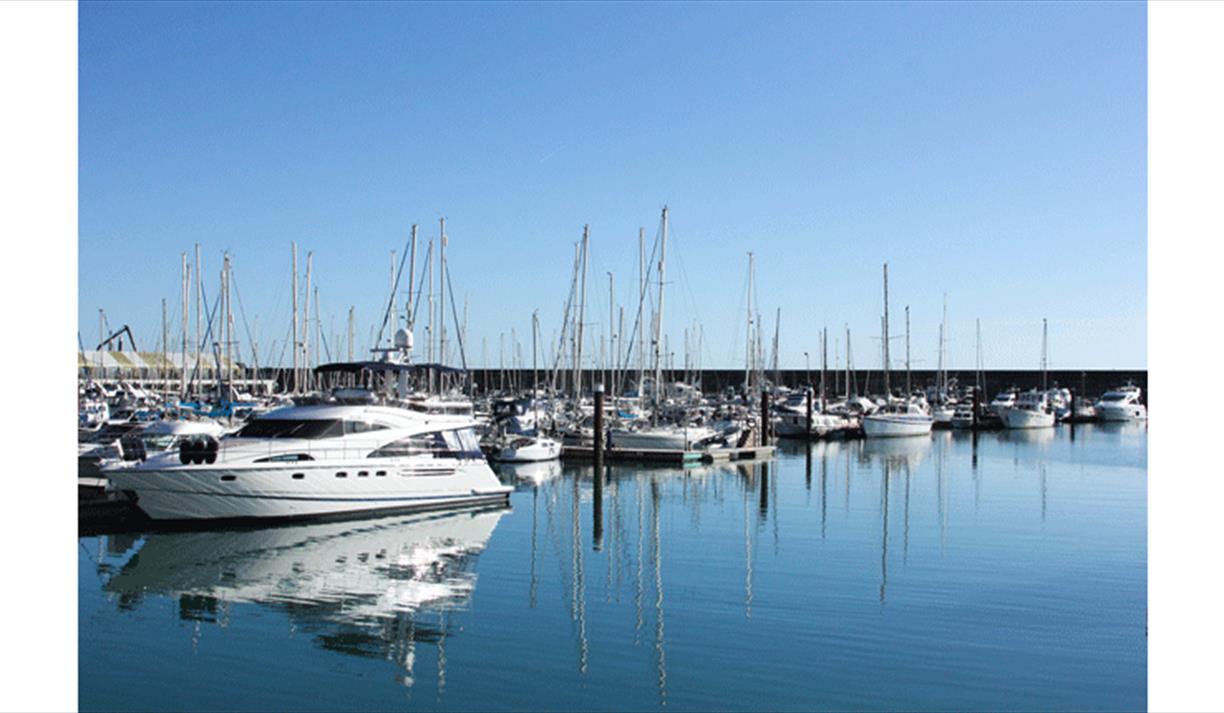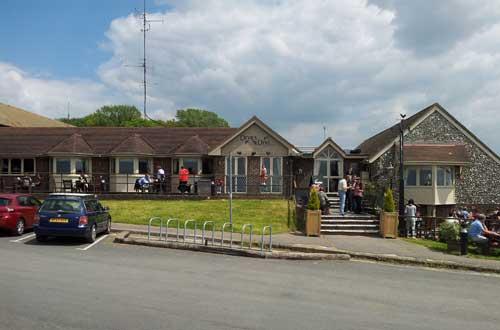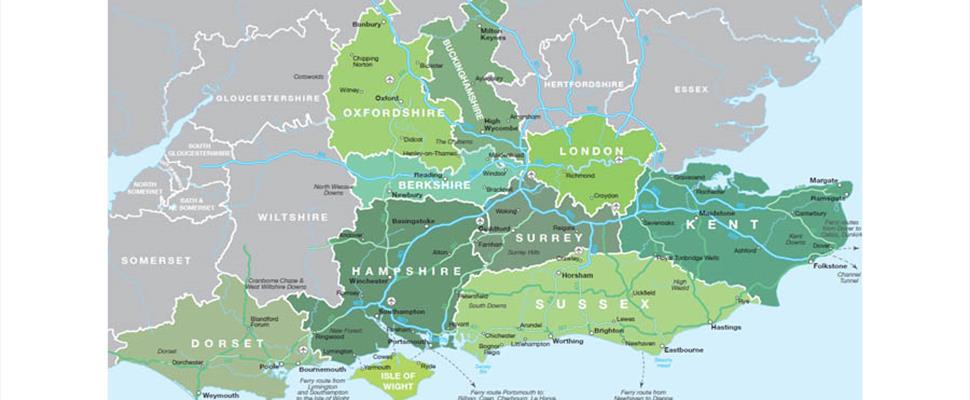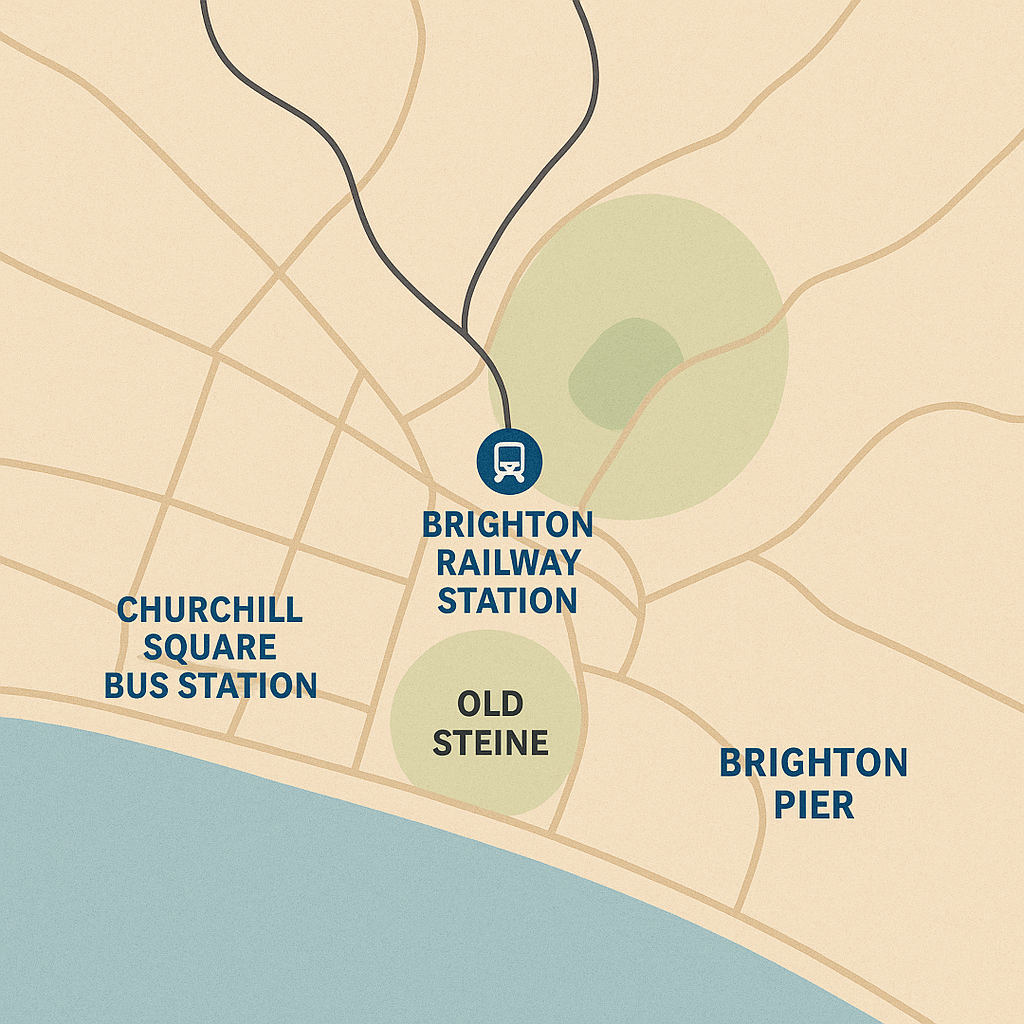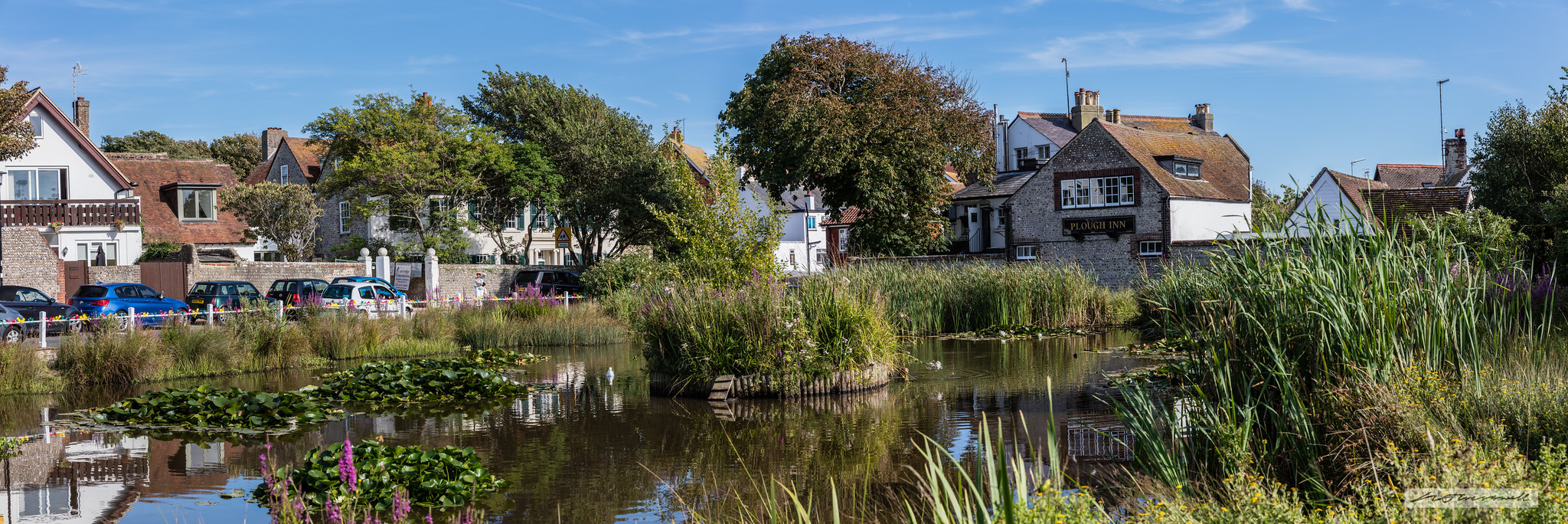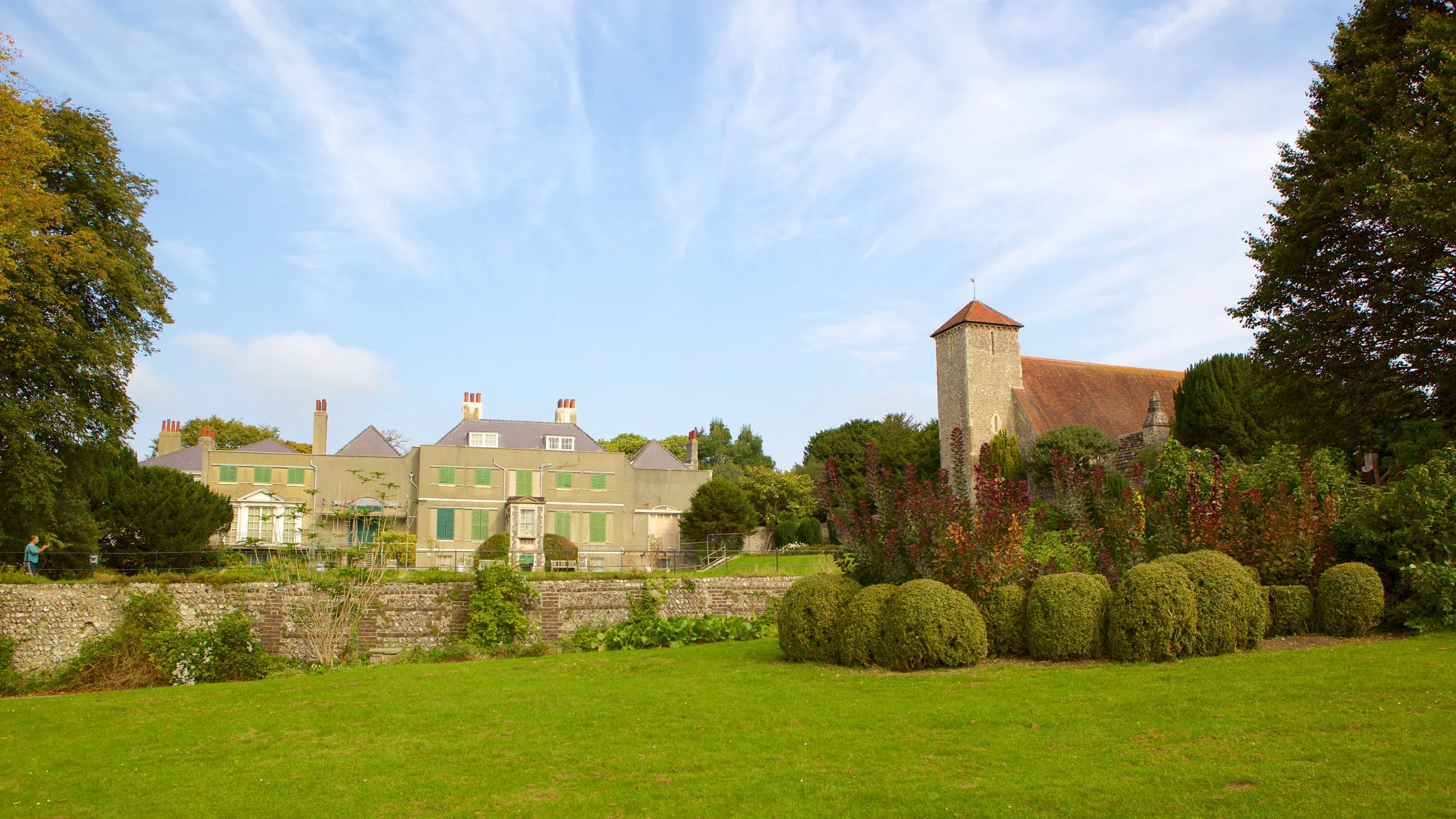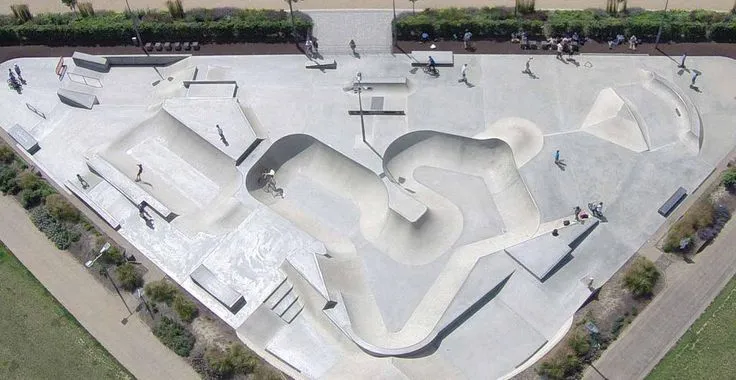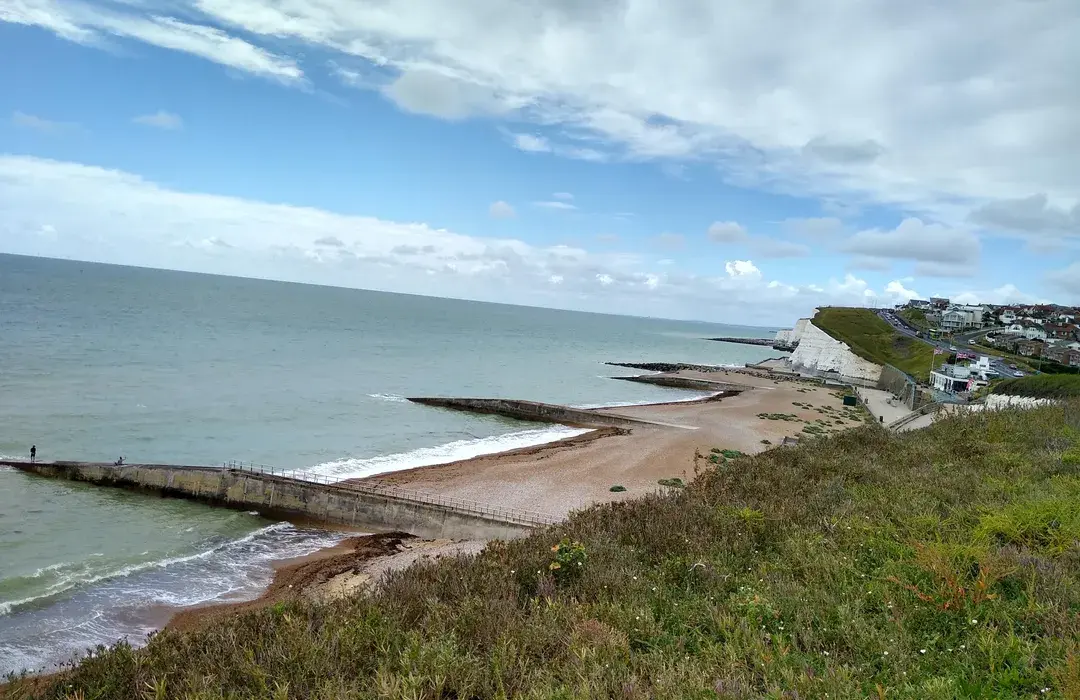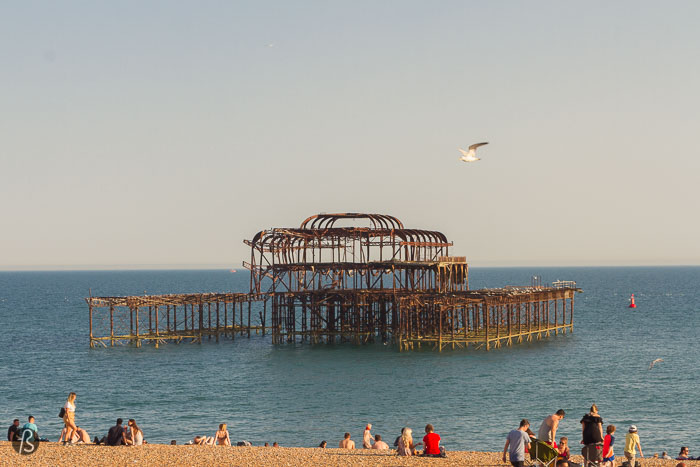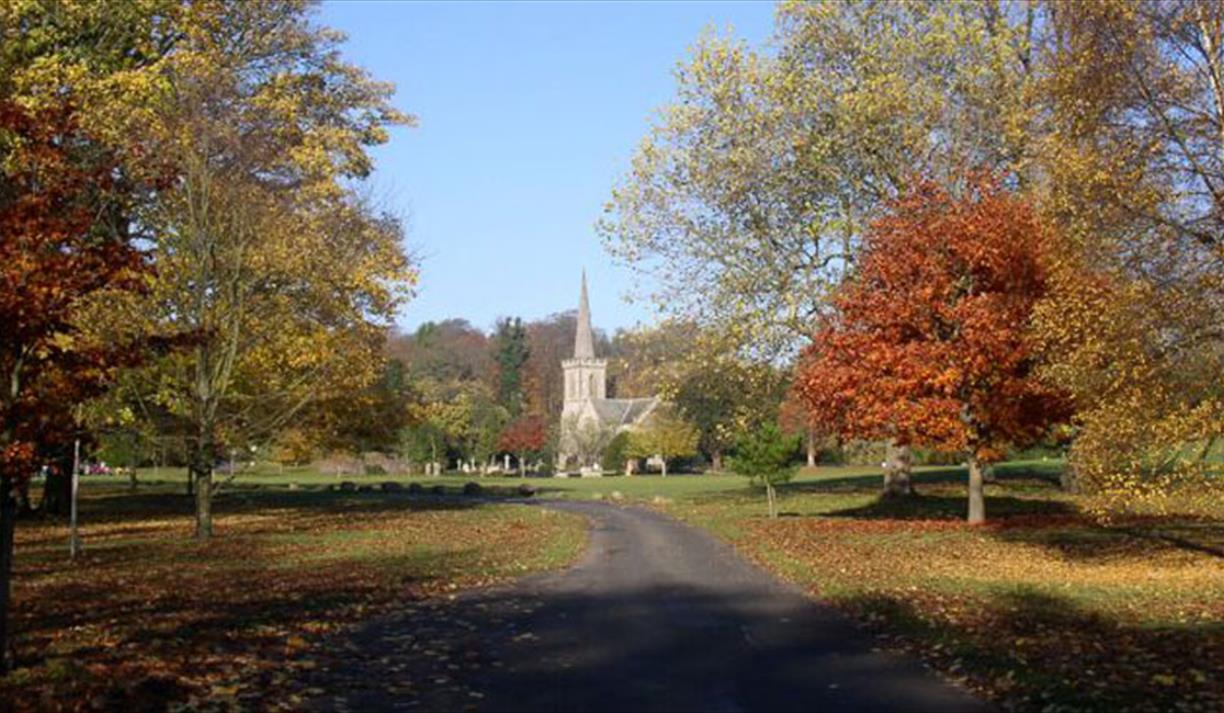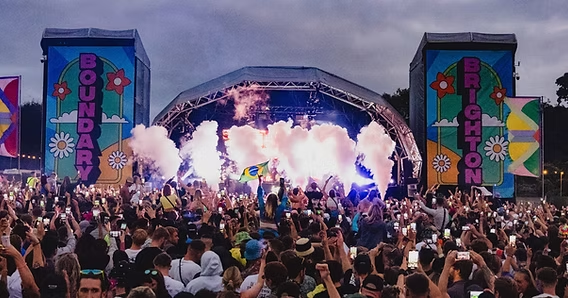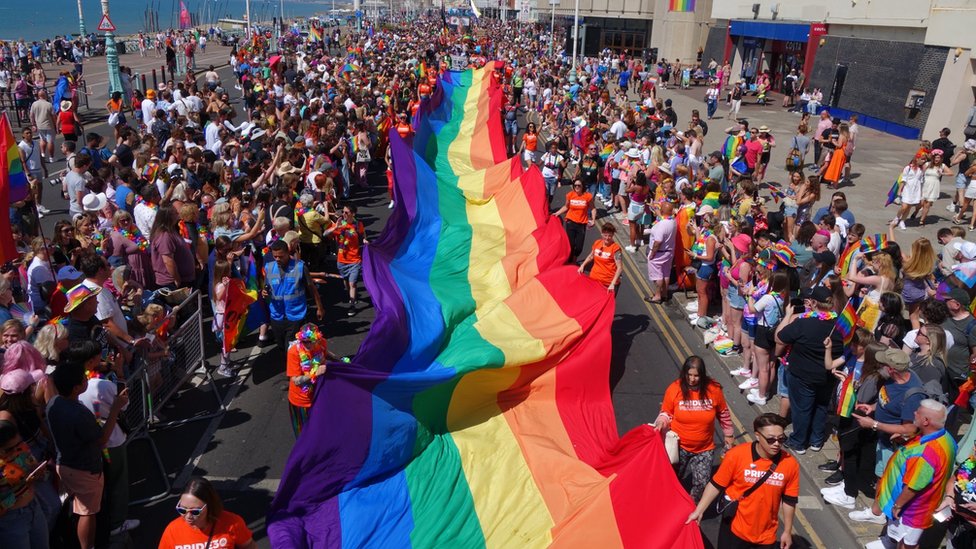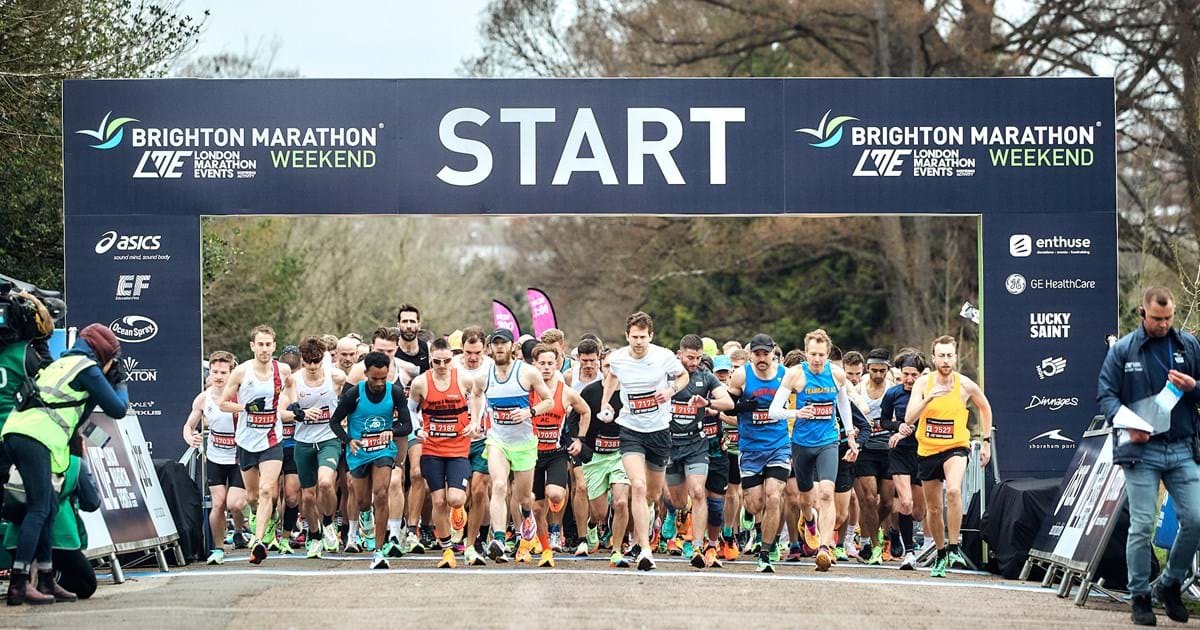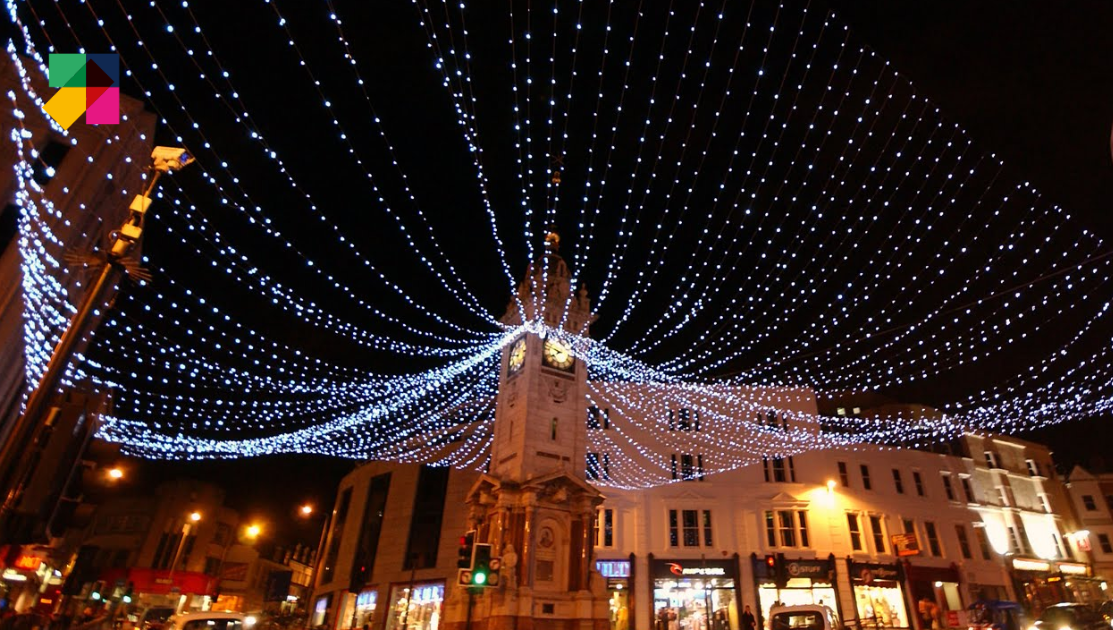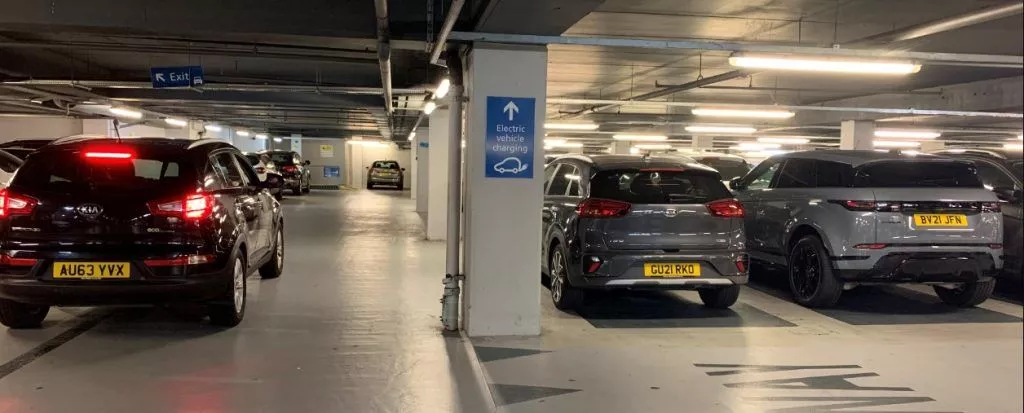Brighton Map England Guide | Roads, Regions & Routes
Plan your Brighton visit with a map that shows top areas, road links, and walking routes from the city centre to the seafront.
Author:Michael RachalReviewer:Finn WildeJul 08, 20254.4K Shares244.9K Views
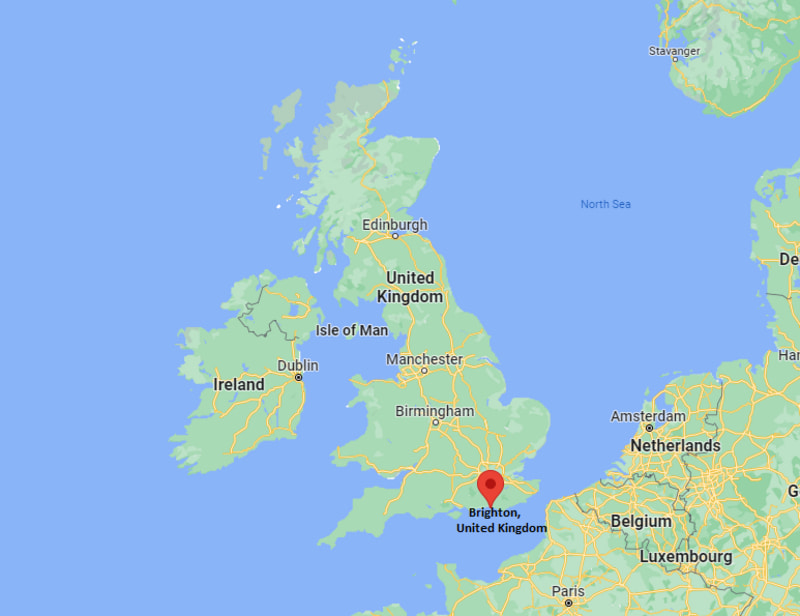
Brighton is a compact seaside city with winding streets, creative neighbourhoods, and a long stretch of coastline. It’s filled with unique places; some easy to find, others tucked away.
Without a clear map, it’s easy to miss key spots or spend extra time getting around. Knowing how the city is laid out makes moving around easier. A good map can help you plan walks, find nearby cafes, or follow the bus routes.
Quick Facts About Brighton, England
- Location: South coast of England, in East Sussex
- Full Name: City of Brighton and Hove (joined in 2000)
- Population: Around 290,000 people
- Known For: Brighton Pier, pebbled beach, Royal Pavilion, and LGBTQ+ friendly culture
- Closest Major City: London(about 1 hour by train)
- Type of City: Unitary authority with its local council
- Seafront: Long promenade with cafes, amusement rides, and beach huts
- Universities: University of Brighton and University of Sussex
- Transport: Well-connected by trains, buses, and bike routes
- Climate: Mild, with cool summers and wet winters
- Tourism: One of the most visited seaside cities in the UK
- Famous Areas: The Lanes, North Laine, Kemptown, and Hove
- Events: Brighton Pride, Brighton Festival, Brighton Marathon
- Economy: Tourism, education, retail, digital media
- Nickname: Often called “London by the Sea”
Geographical Overview Of Brighton Map England
Brighton is located on the southern coast of England, along the English Channel. It sits in the county of East Sussex and is part of the South East England region. The city is about 47 miles (76 km) south of London and is easy to reach by train or car.
On a map, Brighton stretches along the coastline with the beach and seafront running from east to west. Inland, the city climbs gently uphill, with residential areas and parks spreading northward. The map also shows nearby towns like Hove, which is closely linked with Brighton and often considered part of the same urban area. To the east, you’ll find areas like Rottingdean and Saltdean.
To the north lies the South Downs National Park, a wide area of green hills and walking paths. The layout of Brighton is compact, and many of its most popular areas are within walking distance. The city is known for its blend of historic streets, open spaces, and seaside views, all clearly visible when looking at a detailed Brighton map.
History Of Brighton, England
Early Origins
Brighton began as a small fishing village called Brighthelmstone. The name is believed to come from an early Saxon settler named Beorthelm. People have lived in the area for thousands of years, with signs of Roman roads and ancient farming nearby.
By the Domesday Book in 1086, the village had about 400 people and was mainly known for fishing and farming.
Medieval To 17th Century
In the Middle Ages, Brighton grew slowly. The sea often damaged the coastline, and storms sometimes destroyed homes and farmland. It wasn’t a wealthy place, but fishing and trade kept the town going.
In the 1500s and 1600s, Brighton’s population dropped, and it struggled with poverty. Smuggling became common along the coast during these hard times.
18th Century - Start Of Growth
Brighton began to change in the 1700s, when people believed that seawater could cure health problems. Dr. Richard Russell, a local doctor, promoted sea bathing and encouraged people to visit Brighton for their health.
Wealthy visitors from London started coming, and Brighton slowly became a fashionable seaside resort.
19th Century - Royal Fame And Expansion
In the early 1800s, Prince Regent (later King George IV) started visiting Brighton often. He built the famous Royal Pavilion, a unique and grand palace with Indian and Chinese-style design. This royal attention made Brighton very popular among the upper class.
Brighton continued to grow with better roads and new buildings. The arrival of the railway in 1841 made it much easier for people from London to visit. This changed everything; thousands of day-trippers and holidaymakers began flooding into the city.
20th Century - Seaside Fun And Suburban Growth
During the early 1900s, Brighton was one of the UK’s top seaside destinations. Visitors enjoyed the beach, Brighton Pier (opened in 1899), and the lively arcades and theatres.
After World War II, Brighton expanded further with new housing and schools. It became more modern, while still keeping its seaside charm.
In the 1960s and 70s, Brighton became known for its creative energy, attracting artists, musicians, and students.
21st Century - A Modern Coastal City
In the year 2000, Brighton officially joined with neighbouring Hove to form the City of Brighton and Hove. The city kept growing and is now known for its progressive culture, digital economy, green values, and strong support for diversity.
Today, Brighton is a mix of old and new historic buildings, busy shopping streets, and modern seaside attractions. It remains one of the UK’s most popular places to live, study, and visit.
Related Reading - Map Of England - Detailed Guide With Cities, Regions, & History
Key Cities And Towns Around Brighton On The Map
Hove
Hove sits directly next to Brighton on the western side. Although it used to be a separate town, Hove is now officially part of the City of Brighton and Hove. It’s known for its peaceful streets, wide beaches, and grand buildings. Compared to busy central Brighton, Hove is quieter and more relaxed. The seafront here is popular with walkers and families.
Worthing
Worthing is a larger coastal town about 11 miles west of Brighton. It also faces the sea and has long beaches, theatres, and a calm atmosphere. Many people from Brighton travelto Worthing for a quieter day out. It’s easy to reach by train or bus, and often shown on maps of the wider Brighton area.
Eastbourne
Eastbourne is found to the east of Brighton, about 20 miles away along the coast. It is famous for its long pier, flower-filled gardens, and the nearby white chalk cliffs at Beachy Head. Like Brighton, it’s a popular seaside town, but it has a more traditional feel. A good road and train connection links the two towns, so Eastbourne is often included on Brighton-area maps.
Lewes
Lewes is a small town located northeast of Brighton, surrounded by green countryside. It has a strong history, with a Norman castle, cobbled streets, and many old buildings. Lewes is also known for its large bonfire night celebration in November. It’s easy to visit by train, and it’s often shown on maps because it’s the county town of East Sussex.
London
Although London is not very close, it’s often shown on larger-scale maps that include Brighton. This helps people understand Brighton’s location in relation to the capital. London is about one hour away by train, which makes Brighton a popular place for weekend trips and even daily commuting.
Regions And Neighbourhoods On The Brighton Map England
City Centre
The city centre is the busiest part of Brighton. It includes the main shopping streets, Brighton Station, and attractions like the Royal Pavilion. You’ll find lots of restaurants, cafes, shops, and entertainment venues here. It’s also a main point for public transport. Many visitors start their journey in the city centre.
The Lanes And North Laine
The Lanes represent Brighton's historic heart, featuring a maze of narrow streets filled with antique shops, jewelry stores, and traditional pubs. These medieval lanes can confuse even experienced visitors due to their irregular layout and similar-looking passages. The key to navigating The Lanes is to use North Street as your main reference point - it runs along the northern edge of this district.
Kemptown And Hanover
Kemptown extends east from the Old Town toward Brighton Marina. This area includes some of Brighton's most impressive Regency architecture, particularly around Kemp Town Enclosures and Sussex Square. The streets here follow a more planned layout than the Old Town, with many running parallel to the seafront.
Preston Park And Fiveways
Preston Park marks Brighton's main northern residential area, centered around the large park of the same name. This district features tree-lined streets and Victorian terraced houses. The area uses Preston Road as its main north-south artery, connecting to London Road and providing easy access to the city center.
Hollingbury & Moulsecoomb
Located further north, these areas are mainly residential, with schools, parks, and community centres. Moulsecoomb is home to part of the University of Brighton and has a younger student population. Hollingbury is known for housing estates, local shops, and easy access to the South Downs countryside.
Seafront & Brighton Pier
The seafront runs along the beach and includes popular spots like the Brighton Palace Pier, i360 tower, and the long promenade. It’s perfect for walking, relaxing, or enjoying seaside attractions. Maps often highlight this area because it’s one of Brighton’s most visited parts.
Total Area Of Brighton, England
The total area of Brighton and Hove, which includes both Brighton and its neighbouring town Hove, is about 82.67 square kilometres (or around 31.9 square miles). This space covers the city centre, coastal areas, parks, residential neighbourhoods, and parts of the nearby South Downs countryside.
Although the area is not very large, Brighton is densely packed with homes, shops, schools, and tourist spots, making it one of the most active and well-used coastal cities in England.
Population Of Brighton Map England
As of recent estimates, the City of Brighton and Hove has a population of around 290,000 people. Brighton itself, not counting Hove, holds the majority of that number.
The population shown on a Brighton map is spread across both urban and suburban areas. Central Brighton and the seafront are more densely populated, especially with young professionals, students, and visitors. Further inland and toward Hove, the areas are more residential, with families and older residents.
Must-Visit Landmarks And Their Exact Locations
Royal Pavilion - Church Street, BN1 1EE
The Royal Pavilion stands as Brighton's most iconic landmark, located in the heart of the city center just north of the Old Steine. This extraordinary Indo-Saracenic palace sits in its own gardens, surrounded by Church Street, North Street, and New Road. The building's distinctive onion domes make it visible from several directions, serving as an excellent navigation reference point.
Approaching the Royal Pavilion from Brighton station requires a 10-minute walk south down Queen's Road, then turning left onto North Street. From the seafront, walk north from Brighton Pier along the Old Steine - the pavilion's gardens will appear on your right after about 300 meters.
Brighton Pier - Madeira Drive, BN2 1TW
Brighton Palace Pier extends into the English Channel from the seafront at the bottom of the Old Steine. This Victorian pleasure pier features amusement arcades, rides, and food stalls, making it Brighton's most visited attraction. The pier's distinctive white structure and prominent signage make it impossible to miss when walking along the seafront.
From Brighton station, follow Queen's Road south until it becomes West Street, then continue straight to the seafront. Turn left along the promenade and Brighton Pier will be visible ahead. The walk takes approximately 15 minutes and passes through Brighton's main shopping and entertainment district.
The Lanes - Between North Street And King's Road
The Lanes occupy the historic core of old Brighton, bounded by North Street to the north, King's Road to the south, East Street to the east, and West Street to the west. This network of narrow medieval streets contains dozens of individual lanes, each with its own character and selection of shops, restaurants, and pubs.
Navigation within The Lanes requires patience and a willingness to explore. The main access points include entrances from North Street near the Clock Tower, from East Street near the seafront, and from several points along King's Road. Many lanes interconnect, but some end in courtyards or lead back to the same street, so keeping track of your general direction helps prevent confusion.
Brighton I360 - Lower Kings Road, BN1 2LN
The British Airways i360 represents Brighton's newest landmark - a 162-meter observation tower that opened in 2016. This striking cylindrical tower sits on the seafront between the ruins of the West Pier and Hove, offering 360-degree views over Brighton and the surrounding countryside.
The i360 sits about one mile west of Brighton Pier along the seafront promenade. Walking from the city center takes 15-20 minutes along King's Road Arches or the upper promenade. Several bus routes serve the area, with stops near the tower entrance on Kings Road.
Brighton Marina - Marina Way, BN2 5WA
Brighton Marina creates an impressive sight from both land and sea, featuring hundreds of yachts and boats alongside shopping, dining, and entertainment facilities. The marina sits approximately two miles east of Brighton city center, built within artificial harbor walls that extend into the English Channel.
Reaching Brighton Marina requires either a 30-40 minute walk along the seafront from Brighton Pier, or a bus journey using routes 7, 14, or 47. The seafront walk offers excellent views but includes some steep sections as the path follows the natural cliff line. The Volks Railway provides a scenic alternative during summer months.
Devil's Dyke - Devil's Dyke Road, BN1 8YJ
Devil's Dyke represents one of England's deepest and longest dry valleys, located about five miles north of Brighton city center on the South Downs. This dramatic landscape feature offers spectacular views over Brighton, Hove, and the English Channel, making it a popular destination for both tourists and locals.
Reaching Devil's Dyke requires either a car journey via the A23 and local roads, or bus route 77 which operates seasonal services from Brighton city center. The walk from Brighton to Devil's Dyke covers approximately five miles and includes significant uphill sections, but follows well-marked public footpaths through beautiful downland scenery.
Language Of Brighton, England
The main language spoken in Brighton is English. It is the official language used in schools, government offices, shops, and public services. Most people living in Brighton speak English as their first language, and visitors will find it easy to communicate in everyday situations like ordering food, asking for directions, or using transport.
However, Brighton is also a very diverse and international city. Because it is home to two universities and attracts people from all over the world, you can often hear other languages spoken too. Some common languages you might hear in certain areas include Polish, Arabic, French, Spanish, and Chinese.
Types Of Brighton Map England
There are many types of maps you can use to find your way around Brighton. Each map is made for a different purpose, so choosing the right one depends on what you need. Below are the most useful types of Brighton maps:
1. Street Map
A street map shows the roads, buildings, parks, and important places in the city. It helps you:
- Find specific addresses
- Locate schools, hospitals, shops, and hotels
- Understand how areas are connected
- Navigate by foot, car, or public transport
2. Tourist Map
Tourist maps highlight popular places to visit, such as:
- Brighton Pier
- The Royal Pavilion
- The Lanes
- Museums and parks
They usually include icons and colours to make it easy for visitors to find attractions, toilets, transport, and food spots.
3. Transport Map
A transport map shows:
- Bus routes and numbers
- Train stations
- Bike lanes and rental stations
- Park & Ride locations
- Walking routes to key areas
These maps help you plan how to move around Brighton without getting stuck in traffic or lost.
4. Walking Map
Walking maps focus on:
- Pedestrian paths
- Walking tours
- Scenic routes along the beach
- Historical or cultural trails
They are perfect if you want to enjoy the city on foot and take in the sights at your own pace.
5. Cycling Map
Brighton is a bike-friendly city. Cycling maps include:
- Dedicated cycle paths
- BTN BikeShare stations
- Bike-friendly streets
- Parks and seafront cycle routes
They help cyclists avoid busy roads and find the safest and easiest routes.
6. Accessibility Map
Accessibility maps show:
- Step-free routes
- Lifts and ramps
- Accessible toilets
- Disabled parking areas
- Mobility support services
These maps are useful for people using wheelchairs, prams, or those with limited mobility.
7. Digital Map
Digital maps are apps like:
- Google Maps
- Apple Maps
- Citymapper
- Maps.me
- OpenStreetMap
They offer live directions, traffic updates, and location sharing. Many can be used offline if downloaded in advance.
8. Historical Map
Historical maps show what Brighton looked like in the past. They are useful for:
- Students and researchers
- Understanding how the city has changed over time
- Exploring old buildings and forgotten streets
You can find some of these at local libraries or online archives.
Major Roads And Routes In Brighton, England
Brighton is linked to other parts of the UK through key roads like the A23 and A27. The A23 runs north to London, turning into the M23 motorway, and is a main route for drivers and coaches. The A27 runs east to west along the edge of the city, connecting Brighton to Lewes, Eastbourne, Worthing, and beyond.
Inside the city, major streets include London Road, Lewes Road, Western Road, and Kings Road along the seafront. These roads are used daily by cars, buses, and cyclists. Brighton’s road layout includes many one-way systems, especially in the city centre, so having a map or GPS helps when driving.
Public transport follows many of these main routes, with clear signs and bus stops. Walking and cycling paths often run alongside or near major roads, offering safe alternatives for getting around the city without a car.
Key Transportation Hubs And How To Navigate Them
Brighton Railway Station
Brighton's main railway station sits about half a mile north of the seafront and serves as the primary arrival point for most visitors. The station features a distinctive Victorian architecture with modern additions that can confuse first-time users. The main entrance faces north toward the city center, not south toward the sea as many expect.
From the station, Queen's Road leads directly south toward the seafront, passing through the main shopping district. This route takes about 10-15 minutes on foot and passes several landmarks that help with orientation, including Churchill Square shopping center and the Town Hall.
The Old Steine
The Old Steine functions as Brighton's main traffic roundabout and serves as the central reference point for the city's bus network. This large open space sits just inland from Brighton Pier and connects several major roads. Most bus routes either pass through or terminate near the Old Steine, making it crucial for public transport navigation.
The area around the Old Steine includes several important buildings and landmarks, including the Royal Pavilion, Brighton Museum, and the Dome concert hall. These landmarks help visitors orient themselves when arriving by bus or when planning walking routes around the city center.
Churchill Square Bus Station
Churchill Square serves as Brighton's main bus terminal, handling both local and long-distance services. The bus station sits beneath the Churchill Square shopping center, which can make it difficult to find for first-time visitors. Clear signage from Western Road and North Street helps guide pedestrians to the bus station entrances.
Different bus companies operate from different parts of the bus station, so checking your departure point in advance saves time and confusion. National Express coaches use dedicated bays separate from local bus services, while some local routes start from street-level stops around the square rather than the underground terminal.
Brighton Pier Area
Brighton Pier serves as both a major tourist attractionand an important navigation landmark. The area around the pier includes several transport options, including the starting point for the Volks Railway, taxi ranks, and bus stops for seafront services.
The promenade around Brighton Pier can become extremely crowded during peak season, making navigation challenging. Alternative routes through the adjacent streets often prove faster for pedestrians trying to move east or west along the seafront.
Preston Park Station
Preston Park provides Brighton's secondary railway station, serving some London trains and local services toward Lewes and Eastbourne. This station sits in a residential area about two miles north of the city center and connects to the main city via Preston Road and London Road.
Many visitors overlook Preston Park station, but it can provide a useful alternative to Brighton's main station, especially for those staying in the northern parts of the city or traveling onward to other Sussex destinations.
Hove Station
Hove station serves the western part of the Brighton and Hove area and provides an alternative arrival point for visitors staying in western Brighton or Hove itself. The station sits about one mile west of Brighton city center and connects to the seafront via Church Road.
From Hove station, visitors can walk to central Brighton along the seafront in about 20-25 minutes, enjoying sea views along the way. Several bus routes also connect Hove station to Brighton city center for those preferring not to walk.
Brighton Marina
Brighton Marina includes its transport interchange, serving buses to the city center and other local destinations. The marina's retail complex includes clear signage for public transport options, but the layout can confuse visitors unfamiliar with the area.
The Volks Railway provides a seasonal connection between Brighton Marina and the city center, offering scenic views along the seafront. However, this service operates limited hours and doesn't run during winter months, so checking schedules before relying on this transport option is essential.
Hidden Gems Only Locals Know
Rottingdean Village
Rottingdean sits three miles east of Brighton Marina, offering a glimpse of traditional Sussex village life that most tourists never see. This picturesque village features a historic windmill, village pond, and the former home of author Rudyard Kipling. The village sits in a valley that leads to the sea, with dramatic chalk cliffs on either side.
Getting to Rottingdean requires bus route 2A or 2B from Brighton city center, or a pleasant walk along the Undercliff Walk from Brighton Marina. The coastal path offers stunning views but includes several steep sections and can be challenging in bad weather.
Preston Manor And Park
Preston Manor provides one of Brighton's best-preserved Edwardian houses, complete with original furnishings and a fascinating servant's quarters. The manor sits within Preston Park, Brighton's largest green space, but many visitors focus only on the park while missing the historic house entirely.
The manor sits on Preston Drove, easily reached by bus routes along London Road or Preston Road. Alternatively, a 20-minute walk north from Brighton station via Preston Road provides good exercise and passes through some of Brighton's most attractive residential areas.
The Level Skate Park
The Level represents one of Europe's most impressive concrete skate parks, hidden away in a former Victorian park between London Road and Union Road. This free facility attracts skateboarders from across the country but remains unknown to most tourists, despite its central location.
Walking to The Level from Brighton station takes about 10 minutes north along Queen's Road, then turning right onto Union Road. The park also features children's play areas, basketball courts, and plenty of green space for picnics or relaxation.
Undercliff Walk
The Undercliff Walk provides a spectacular clifftop path between Brighton Marina and Saltdean, offering views that rival any in southern England. This three-mile path passes through several nature reserves and provides access to secluded beaches that few visitors discover. It's also a peaceful alternative to the busy Brighton beach england, giving walkers a more natural and quiet coastal experience.
Starting the walk from Brighton Marina requires finding the path at the eastern end of the harbor development. The route can be challenging in places, with steep steps and narrow sections, but rewards walkers with incredible coastal scenery and wildlife viewing opportunities.
Black Rock Swimming Pool Ruins
The remains of Brighton's former open-air swimming pool sit on the shore between Brighton Marina and Rottingdean. Built in the 1930s and destroyed by storms in the 1970s, the concrete structures create an atmospheric ruins that photographers and history enthusiasts love to explore.
Reaching the ruins requires walking east from Brighton Marina along the beach or coastal path for about one mile. The area can only be accessed at low tide, and the concrete structures can be slippery, so caution is essential when exploring.
Stanmer Park And Village
Stanmer Park covers 200 hectares of downland, woodland, and farmland just four miles north of Brighton city center. The park includes a preserved medieval village, organic farm, and extensive walking trails that provide excellent views over Brighton and the surrounding countryside.
Bus route 78 provides regular services to Stanmer Park from Brighton city center, or adventurous visitors can walk from the city via various public footpaths. The park offers excellent mountain biking trails and hosts regular events throughout the year.
Brighton Maps For Events And Seasonal Attractions
Brighton Festival
The Brighton Festivaltakes place every May and is one of the biggest arts festivalsin England. It includes live music, theatre, dance shows, talks, and outdoor performances in different parts of the city. A special event map is usually available to help visitors find their way between venues
These maps show where performances are being held, where you can buy tickets, and how to walk between locations. Since many events are spread across Brighton, the map makes it easier to plan your day and not miss anything you want to see.
Brighton Pride
Brighton Pride is one of the UK’s largest LGBTQ+ celebrations and happens every August. Thousands of people visit the city to take part in or watch the parade, attend concerts, and enjoy the festival atmosphere. Because the city becomes very busy, a detailed Pride map is provided.
It shows the full parade route, locations of the main stages, first aid tents, safe spaces, and accessible toilets. It also highlights streets that are closed to traffic, making it easier for people to find the best viewing spots and navigate the crowds safely.
Brighton Marathon
The Brighton Marathon usually takes place in April and attracts runners from across the country. The marathon course goes through several parts of the city, including along the seafront and through the city centre. A race day map helps runners understand the full route and helps spectators know where to watch the race.
These maps also show water stations, medical tents, toilets, and areas where traffic will be blocked. For those not taking part in the race, the map is useful for avoiding road closures and finding alternative transport routes.
Christmas In Brighton
During the winter months, especially in December, Brighton is decorated with Christmas lights and hosts many festive events. The city often sets up special markets, food stalls, and light trails across key shopping streets and open spaces.
A holiday map is usually available to help visitors find the main attractions, such as the Christmas market, Santa’s grotto, and areas with special decorations. These maps also mark public toilets, nearby bus stops, and car parks to make visiting the city easier during the busy festive season.
Temporary Closures And Transport Changes
During large events, some roads and bus routes in Brighton are temporarily changed or closed. This is done to manage crowds and make space for parades, stages, or safety services. To help people keep moving, the city shares updated transport maps.
These maps are available online and in printed form before and during the events. They help locals and visitors find the best walking paths, check which buses are running, and avoid blocked roads.
Parking Zones And Restrictions
City Center Parking Zones
Brighton city center operates a comprehensive controlled parking zone covering most streets within a mile radius of Brighton Pier. Parking restrictions typically operate Monday through Saturday from 8:30 AM to 6:00 PM, with some areas extending restrictions to include Sunday and evening hours during summer months.
Seafront Parking Options
Madeira Drive, which runs along Brighton's seafront, provides extensive on-street parking with spectacular sea views. However, this prime location comes with premium pricing and high demand, particularly during summer months and weekends. Parking here operates under pay-and-display systems with charges varying by season and day of the week.
Alternative Parking Solutions
Several multi-story car parks throughout Brighton offer alternatives to street parking, often with better availability and competitive pricing for longer stays. Churchill Square car park provides direct access to the shopping center and reasonable walking distance to major attractions, while offering weather protection and security.
Park And Ride Services
Brighton operates several park-and-ride sites on the outskirts of the city, designed to reduce traffic congestion while providing convenient access to the city center. The Withdean Park and Ride site, located north of the city near the A23, offers frequent bus services to the city center with journey times of approximately 15-20 minutes.
Fun Facts About Brighton, England
- Brighton’s beach is made of pebbles, not sand: Unlike many seaside towns, Brighton has a unique shingle beach no sand between your toes.
- It has the world’s oldest electric railway: The Volks Electric Railway, opened in 1883, still runs along the seafront today.
- Brighton once had a glass dolphin pool: The old Brighton Aquarium had a dolphinarium with glass walls where dolphins performed shows in the 1960s.
- There’s a secret tunnel under the Royal Pavilion: : Built for King George IV, it allowed him to walk privately from the palace to the stables (now Brighton Dome).
- It was nearly called “Brighthelmstone”: Brighton’s original name before it was shortened in the 19th century.
- Brighton Pier isn’t the first pier: The West Pier, built in 1866, came before but it was destroyed by fire and storm damage. Its remains still stand.
- The city hosts a 'naked bike ride' every year: It’s part of a global protest for cleaner transport yes, many ride completely nude.
- Brighton has its currency: The Brighton Pound was launched to encourage: spending in local businesses.
- More than 8 million people visit every year: Despite its small size, Brighton is one of the UK’s most-visited coastal cities.
- It’s a hotspot for filming: TV shows and movies, like Quadrophenia and Brighton Rock, were filmed in the city’s streets and along the beach.
People Also Ask
How Long Does It Take To Walk From Brighton Station To The Seafront?
Walking from Brighton railway station to the seafront typically takes 12-15 minutes via the most direct route down Queen's Road and West Street. The route is mostly downhill and passes through Brighton's main shopping district, making it an pleasant introduction to the city.
How Can I Find Bike Routes In Brighton?
BTN BikeShare has a digital map showing bike lanes and docking stations. Google Maps and OpenCycleMap also show cycling-friendly roads.
Final Thoughts
Getting around Brighton is easier when you know where things are. A reliable map gives you more time to enjoy the city and less time worrying about directions or missed turns.
Maps are useful not just for reaching places but for understanding the layout and rhythm of the city. With the right one, you can move confidently through Brighton’s streets, parks, and seafront with a better sense of what’s around you.
Jump to
Quick Facts About Brighton, England
Geographical Overview Of Brighton Map England
History Of Brighton, England
Key Cities And Towns Around Brighton On The Map
Regions And Neighbourhoods On The Brighton Map England
Total Area Of Brighton, England
Population Of Brighton Map England
Must-Visit Landmarks And Their Exact Locations
Language Of Brighton, England
Types Of Brighton Map England
Major Roads And Routes In Brighton, England
Key Transportation Hubs And How To Navigate Them
Hidden Gems Only Locals Know
Brighton Maps For Events And Seasonal Attractions
Parking Zones And Restrictions
Fun Facts About Brighton, England
People Also Ask
Final Thoughts

Michael Rachal
Author
Michael Rachal believes that luxury lies in the details. With over 20 years of experience in the luxury travel industry, he has crafted hundreds of bespoke itineraries for clients seeking personalized, unforgettable experiences.
Whether guiding clients through private cultural tours or curating culinary journeys with world-renowned chefs, Michael ensures that each trip is tailored to perfection.
His ability to anticipate needs and exceed expectations has earned him a reputation as a leading expert in luxury travel.

Finn Wilde
Reviewer
For Finn Wilde, the wilderness is more than just a destination - it’s a way of life. Over the past decade, he has led multiple expeditions in some of the world’s most remote regions, from the icy fjords of Greenland to the rugged trails of Patagonia.
Finn emphasizes sustainability in all of his adventures, helping participants connect with nature while promoting responsible exploration. His expeditions inspire individuals to explore the great outdoors while fostering a deep respect for the environment.
Latest Articles
Popular Articles
